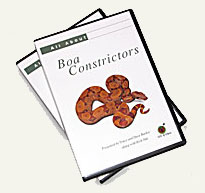Breeding mountain kingsnakes...
Dear VPI,
I have just aquired a pair of these great animals. I know the basics but I can't find much info on breeding. Would it be possible for you to give me some more information. I keep Rosy Boas, Ball Pythons, Mountain Kingsnakes-- Regards Richard
Dear Richard,
Your email address is "woodeni" and you need info on mountain kingsnakes??
Over the years we have successfully bred three mountain kingsnake subspecies--pyromelana, woodini, and knoblochi. Well, I guess most authorities no longer recognize woodini as valid, but it was considered a valid a60.jpg) Chihuahua mountain kingsnakesubspecies back when we were breeding them.
Chihuahua mountain kingsnakesubspecies back when we were breeding them.
We provided the same basic care and temperatures for them that we have used for many other species of kingsnakes.
We have bred them after cooling them to 55-60 degrees F. We also have bred them by giving them very short day lengths while maintaining them at 70-75 degrees F and feeding them small meals. We usually have done some combination, keeping them in a room where the Texas winter weather dictates the temperature regime and we just bar the extremes. If it's warm for a while, we might feed them; we don't want them to have food in their stomachs if its going to get cold.
The point being there is more than one way to do it. It's not necessary to "hibernate" them, even though some papers recommend it; it does work just fine if you choose to do it.
We put pairs together in the spring, usually about mid-April; they breed usually in the first hour or two after being introduced. We leave the male in for a day and then take him out for about three or four days and then put him back in for a day. After several breeding, no more introductions are necessary. We then feed the female heavily until ovulation.
You can see the female get bigger as the follicles grow to mature size. They do actually have a "lump" when they ovulate, but it doesn't last long and it's not as spectacular as in boas and pythons. There is a post-ovulation/pre-lay shed that, if I remember, is about two or three weeks before egg laying.
Always make sure the female has a place to lay the eggs. We used a box of slightly damp sphagnum moss.
It's the regular, unadorned and straightforward colubrid breeding regimen, and we are not aware of any "secrets" or special tricks that are necessary.
Good luck with them, DGB
